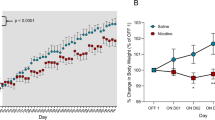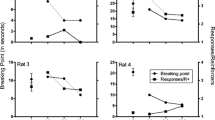Abstract
Pimozide treatment (1.0 and 2.0 mg/kg) decreased free feeding in rats. The animals were presented daily with 35 meal segments, each consisting of five 45-mg pellets; pimozide resulted in longer mean latencies to initiate eating, longer mean eating times per segment (duration scores) and more pellets left uneaten. The increase in durations was progressive both within and across test sessions; toward the end of the final session many pellets were left uneaten. Failure to initiate eating of the first pellet of each segment was rare, and was always preceded by failure to eat the fifth pellet of the preceding meal segment. To assess whether either the increase in latencies or the increase in durations reflected an impairment of absolute response capability, ‘best scores’ in the pimozide and control conditions were compared; the shortest latencies and durations in the pimozide condition were as ‘good’ as those of the control condition. However, the animals generally produced ‘best’ scores on fewer trials in the pimozide condition. An exception was on day 1 of testing, when the frequency of ‘best’ latencies was higher in the pimozide condition. The fact that the ‘best’ scores under pimozide equalled the ‘best’ scores under vehicle suggests that the pimozide-treated animals had the motoric capacity to respond normally. The facts that the pimozide-treated animals did not perform to the demonstrated limits of that capacity in a normal percentage of trials and that performance on days 2 and 3 of testing were ‘worse’ than performance on day 1 of testing suggest that pimozide causes a motivational deficit that has not been widely recognized.
Similar content being viewed by others
References
Ahlenius S (1979) An analysis of behavioral effects produced by drug-induced changes in dopaminergic neurotransmission in the brain. Scand J Psychol 20:59–64
Amsel A, Roussel J (1952) Motivational properties of frustration. I. Effect on a running response of the addition of frustration to the motivational complex. J Exp Psychol 43:363–368
Barbeau A (1974) Drugs affecting movement disorders. Annu Rev Pharmacol 14:91–113
Blundell JE, Tombros E, Rogers PJ, Latham CJ (1980) Behavioral analysis of feeding: Implications for the pharmacological manipulation of food intake in animals and man. Prog Neuropsychopharmacol 4:319–326
deWit H, Wise RA (1977) Blockade of cocaine reinforcement in rats with the dopaminergic receptor blocker pimozide but not with the noradrenergic blockers phentolamine or phenoxybenzamine. Can J Psychol 31:195–203
Fibiger HC, Carter DA, Phillips AG (1976) Decreased intracranial self-stimulation after neuroleptics or 6-hydroxydopamine: Evidence for mediation by motor deficits rather than by reduced reward. Psychopharmacology 47:21–27
Fibiger HC, Zis AP, Phillips AG (1975) Haloperidol-induced disruption of conditioned avoidance responding: Attenuation by prior training or by anticholinergic drugs. Eur J Pharmacol 30:309–314
Fouriezos G, Hansson P, Wise RA (1978) Neuroleptic-induced attenuation of brain stimulation reward. J Comp Physiol Psychol 92:659–669
Fouriezos G, Wise RA (1976) Pimozide-induced extinction of intracranial self-stimulation: Response patterns rule out motor or performance deficits. Brain Res 103:377–380
Franklin KBJ (1978) Catecholamines and self-stimulation: Reward and performance deficits dissociated. Pharmacol Biochem Behav 9:813–820
Franklin KBJ, McCoy SN (1979) Pimozide-induced extinction in rats: Stimulus control of responding rules out motor deficit. Pharmacol Biochem Behav 11:71–76
Gerber GJ, Sing J, Wise RA (1981) Pimozide attenuates lever pressing for water reinforcement in rats. Pharmacol Biochem Behav 14:201–205
Heffner TG, Zigmond MJ, Stricker EM (1977) Effects of dopaminergic agonists and antagonists on feeding in intact and 6-hydroxy-dopamine-treated rats. J Pharmacol Exp Ther 201:386–399
Hornykiewicz O (1975) Parkinsonism induced by dopamine antagonists. Adv Neurol 9:155–164
Janssen P, Niemegeers S, Schellekens KHL, Dresse A, Lenaerts FM, Pinchard A, Schaper WKA, Van Nueten JM, Verbruggen FJ (1968) Pimozide, a chemically novel, highly potent, and orally long-acting neuroleptic. I. The comparative pharmacology of pimozide, haloperidol and chlorpromazine. Arzneim Forsch 18:261–279
Koob GF (1982) The dopamine anhedonia hypothesis: A pharmacological phrenology. Behav Brain Sci 5:63–64
Marshall JF, Barrios N, Sawyer S (1980) Neostriatal dopamine and sensory inattention. J Comp Physiol Psychol 94:833–846
Marx MH, Tombaugh TN, Hatch RS, Tombaugh JW (1965) Controlled operant conditioning boxes with discrete-trial programming for multiple experimental use. Percept Mot Skills 21:247–254
Mason ST, Beninger RJ, Fibiger HC, Phillips AG (1980) Pimozide-induced suppression of responding: Evidence against a block of food reward. Pharmacol Biochem Behav 12:917–923
Posluns D (1962) An analysis of chlorpromazine-induced suppression of the avoidance response. Psychopharmacologia 3:361–373
Rolls ET, Rolls BJ, Kelly PH, Shaw RJ, Wood RJ, Dale R (1974) The relative attenuation of self-stimulation, eating and drinking produced by dopamine-receptor blockade. Psychopharmacology 38:219–230
Spyraki C, Fibiger HC, Phillips AG (1982) Attenuation by haloperidol of place preference conditioning using food reinforcement. Psychopharmacology 77:379–382
Stricker EM, Zigmond MJ (1976) Recovery of function following damage to central catecholamine-containing neurons: A neurochemical model for the lateral hypothalamic syndrome. In: Sprague JM, Epstein AN (eds) Progress in psychobiology and physiological psychology. Academic, New York, pp 121–188
Tombaugh TN, Tombaugh J, Anisman H (1979) Effects of dopamine receptor blockade on alimentary behaviors: Home cage food consumption, magazine training, operant acquisition, and performance. Psychopharmacology 66:219–225
Tombaugh TN, Anisman H, Tombaugh J (1980) Extinction and dopamine receptor blockade after intermittent reinforcement: Failure to observe functional equivalence. Psychopharmacology 70:19–28
Ungerstedt U (1971) Adipsia and aphagia after 6-hydroxydopamine-induced degeneration of the nigro-striatal dopamine system. Acta Physiol Scand (Suppl) 367:95–122
Wise RA (1982) Neuroleptics and operant behavior: The anhedonia hypothesis. Behav Brain Sci 5:39–53
Wise RA, Spindler J, deWit H, Gerber GJ (1978a) Neuroleptic-induced ‘anhedonia’ in rats: Pimozide blocks the reward quality of food. Science 201:262–264
Wise RA, Spindler J, Legault L (1978b) Major attenuation of food reward with performance-sparing doses of pimozide in the rat. Can J Psychol 32:77–85
Yokel RA, Wise RA (1975) Increased lever-pressing for amphetamine after pimozide in rats: Implications for a dopamine theory of reward. Science 187:547–549
Yokel RA, Wise RA (1976) Attenuation of intravenous amphetamine reinforcement by central dopamine blockade in rats. Psychopharmacology 48:311–318
Zis AP, Fibiger HC (1975) Neuroleptic-induced deficits in food and water regulation: Similarities to the lateral hypothalamic syndrome. Psychopharmacology 43:63–68
Author information
Authors and Affiliations
Rights and permissions
About this article
Cite this article
Wise, R.A., Colle, L.M. Pimozide attenuates free feeding: Best scores analysis reveals a motivational deficit. Psychopharmacology 84, 446–451 (1984). https://doi.org/10.1007/BF00431448
Received:
Accepted:
Issue Date:
DOI: https://doi.org/10.1007/BF00431448




